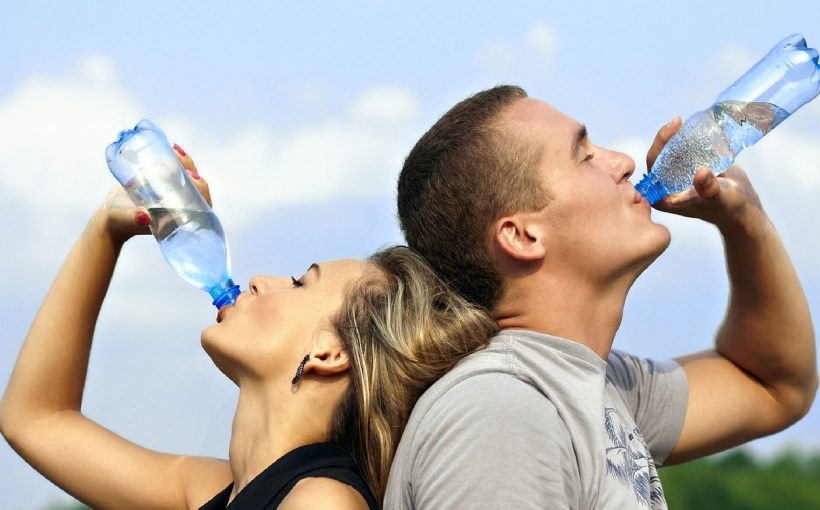The humble liquid comprises about 60% of our body weight and allows our internal organs to perform at their best. Water regulates our body temperature, keeps our joints lubricated and carries nutrients to our cells. Water also provides moisture to skin, ensuring a bright and radiant glow.
Even mild dehydration can be a physical stressor to the body, according to Melissa Majumdar, a registered dietitian and spokesperson for the Academy of Nutrition and Dietetics. If we’re not adequately hydrated, we may experience nausea and loss of appetite, and may find it difficult to concentrate and perform physical tasks, like carrying groceries or lifting weights. So it’s important to drink water. That much we know. And these days, while we stay at home with our reusable cups and convenient access to bathrooms, there’s no good reason not to be drinking water. But how much is enough?
Water recommendations
The Institute of Medicine recommends that women aim to consume 2.7 liters (or 91 ounces) of fluids daily, and men drink 3.7 liters (or 125 ounces). But that recommendation doesn’t focus on water specifically. Rather, it includes all fluids and water-rich foods, including fruits, vegetables and soups. Considering that about 80% of our water intake comes from fluids and about 20% from foods, that breaks down to a daily goal of about 9 cups (or 72 ounces) of fluids for females and 12½ cups (or 100 ounces) for males.
“It’s a very general recommendation,” explained Majumdar, who pointed out that factors like activity level, body composition and even climate all play a role in one’s water needs. “If you are a long-distance runner and lose a lot of fluid through sweat, particularly in hot, humid conditions, you will need much more water than weekend warrior who is doing a short jog in the gym. “Additionally, since muscle cells have a higher concentration of water than fat cells, someone with more lean muscle mass will have higher water needs — and may need to consume more water — than someone with more fat mass. “A leaner person requires more water,” Majumdar said, though she noted “they are probably more active anyway and will be drinking more as a result. “Other factors to consider include pregnancy and breastfeeding, both of which increase fluid needs, as well as illness and extreme temperatures (both hot and cold).
What counts as water
While water is often the default beverage of choice for many nutritionists, other beverages can be included as part of your daily fluid intake, such as nutrient-rich milk, seltzer and even coffee and tea. “All fluids with the exception of alcohol fall under that [fluid] bucket,” Majumdar said. While it’s a misconception that coffee and tea cause extra fluid loss from the body and are dehydrating, alcohol does have a diuretic effect and can increase the risk for dehydration. “Alcohol will pull out other fluids,” Majumdar said, “but coffee and tea provide fluid and are hydrating.”
Dairy or non-dairy milks can deliver important nutrients like protein, calcium and vitamin D. Even though a sugar-containing cola can technically hydrate, “for health and wellness, it’s best to avoid sugar-containing beverages as much as possible,” Majumdar said. These beverages are typically devoid of beneficial nutrients. An exception is 100% fruit juice; however, too much juice delivers a concentrated source of sugar — without the fiber that comes from eating the whole fruit. The institute’s recommendation accounts for water-rich foods, too, like watermelon, oranges, apples, grapes, cucumbers, lettuce, celery and cabbage. The water obtained from foods, however, is difficult to measure. “From a tracking purpose, it’s easier to stick with things that pour,” Majumdar said.
Is more water better?
Since water is vital to our daily functioning, you might be wondering if there is a benefit to drinking, say, a gallon or more of water (a gallon is 128 ounces). But experts say contrary to what many people believe, exceeding our fluid needs provides no additional benefit.
In fact, endurance athletes who drink too much water, in the absence of electrolytes, run the risk of hyponatremia, a life-threatening condition characterized by low sodium levels in the blood that occurs with overhydration. “I’ve had clients end up with dangerously low sodium levels from overhydrating that required immediate medical attention to correct,” said Wendy Sterling, a board-certified sports dietitian and coauthor of “How to Nourish Your Child Through an Eating Disorder. “Most people would benefit by simply ensuring that they meet their daily water needs — something Majumdar said not enough people are doing. “Carry a water bottle around like it’s your third arm,” Majumdar advised. If the lack of flavor of plain water is a deterrent, try adding slices of lemon, lime or orange to water. And don’t forget to alternate cocktails and wine with water or seltzer to stay hydrated.
While it may not always be practical to count up ounces during the day, for most of us, using a combination of thirst as a guide, as well as looking for a pale yellow urine color, can indicate that we are well-hydrated. Exceptions include older adults and those who exercise intensely or for long periods, who may not be able to rely on thirst during a workout and may need to follow a specific hydration plan. Additionally, some medications or vitamins can impact urine color, Majumdar said.
Lisa Drayer


